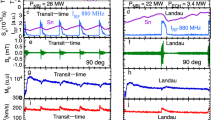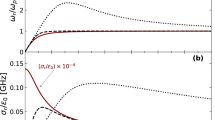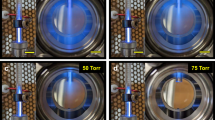Abstract
THE various collisional processes of electron attachment in electronegative gases are of interest in the examination of the properties of ionized gases not only in gas discharge tubes but also in the upper atmosphere, so that the data on attachment cross-sections are important. When the electric field E is high enough to produce ionization by electrons by collision, the attachment cross-sections cannot be measured by the direct methods possible at low electron energies. At high electron energies, however, the total cross-section can be calculated from data on the coefficient of attachment defined in a way analogous to that of α, the coefficient of primary ionization. The coefficient of attachment must be computed from measurements on the growth of ionization currents, preferably between parallel plates. In the presence of attachment the steady-state spatial growth of ionization in a uniform electric field at a constant value of E/p (p the gas pressure) can be represented by:  where I is the amplified ionization current, at an electrode separation d, resulting from a small externally maintained current I0(∼10−13 A), α′ is the apparent primary ionization coefficient, ω a generalized secondary ionization coefficient and at the total attachment coefficient representing the action of several possible attachment processes.
where I is the amplified ionization current, at an electrode separation d, resulting from a small externally maintained current I0(∼10−13 A), α′ is the apparent primary ionization coefficient, ω a generalized secondary ionization coefficient and at the total attachment coefficient representing the action of several possible attachment processes.
This is a preview of subscription content, access via your institution
Access options
Subscribe to this journal
Receive 51 print issues and online access
$199.00 per year
only $3.90 per issue
Buy this article
- Purchase on Springer Link
- Instant access to full article PDF
Prices may be subject to local taxes which are calculated during checkout
Similar content being viewed by others
References
Dutton, J., Harris, F. M., and Llewellyn-Jones, F., Proc. Phys. Soc., 81, 52 (1963).
Crompton, R. W., Dutton, J., and Haydon, S. C., Proc. Phys. Soc., 69, 2 (1956).
Jones, Eifionydd, and Llewellyn-Jones, F., Proc. Phys. Soc., 80, 450 (1962).
Dutton, J., Llewellyn-Jones, F., and Palmer, R. W., Proc. Phys. Soc., 78, 569 (1961).
Harrison, M. A., and Geballe, R., Phys. Rev., 91, 1 (1953).
Prasad, A. N., and Craggs, J. D., Proc. Phys. Soc., 77, 385 (1961).
DeBitetto, D. J., and Fisher, L. H., Phys. Rev., 111, 390 (1958).
Author information
Authors and Affiliations
Rights and permissions
About this article
Cite this article
DUTTON, J., LLEWELLYN-JONES, F. & MORGAN, G. Electron Attachment in Oxygen. Nature 198, 680–681 (1963). https://doi.org/10.1038/198680a0
Issue Date:
DOI: https://doi.org/10.1038/198680a0
Comments
By submitting a comment you agree to abide by our Terms and Community Guidelines. If you find something abusive or that does not comply with our terms or guidelines please flag it as inappropriate.



